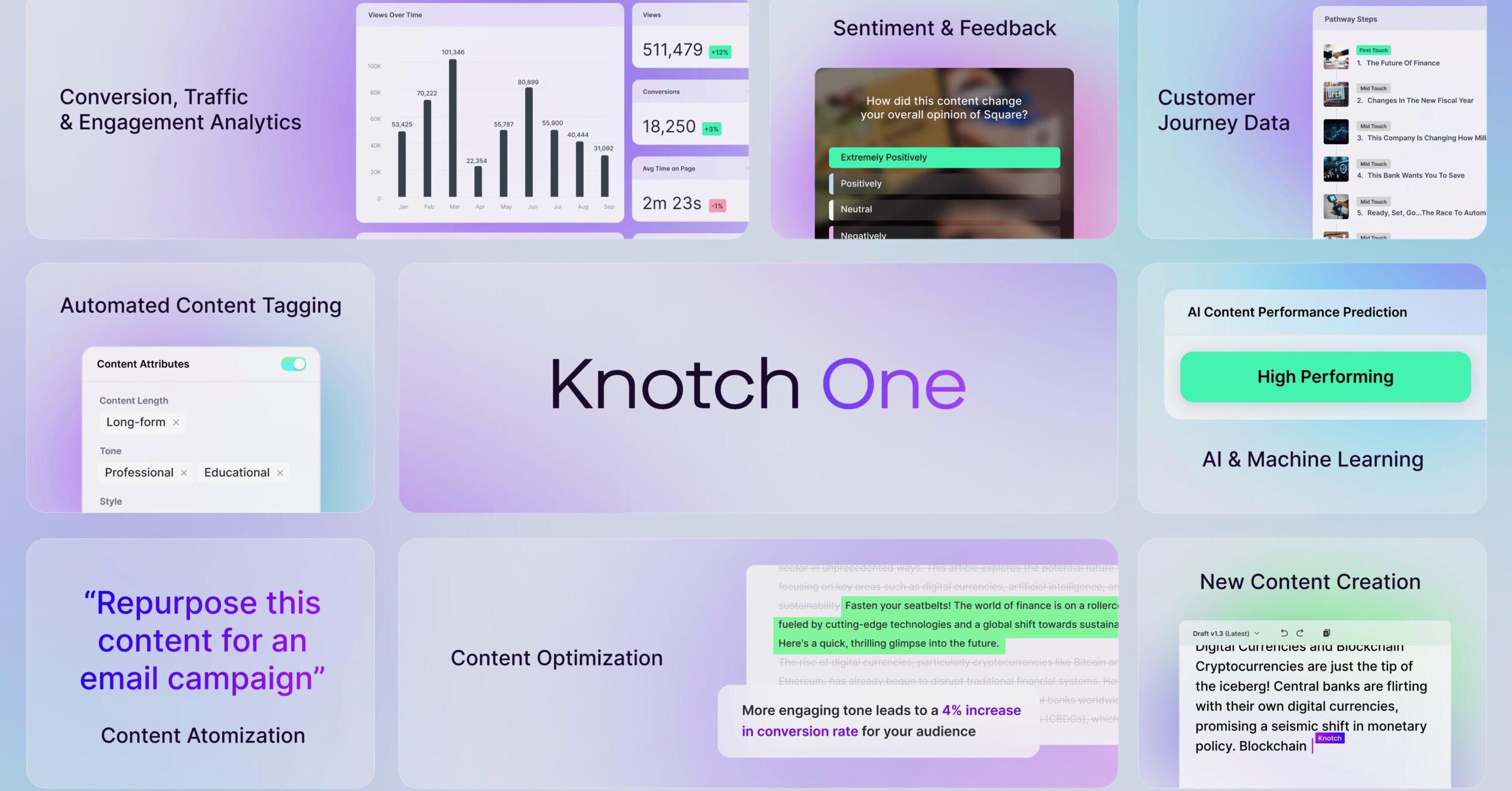The key to measuring content effectiveness
When it comes to measuring content effectiveness, more than two-thirds of marketing teams report that they’re not confident in their strategies for determining the ROI of their content campaigns. That’s not really a surprise, as most content measurement tools aren’t able to provide the data that teams needs to monitor content marketing KPIs. Many solutions for measuring content effectiveness are limited in scope and use unreliable third-party data. And very few solutions can deliver the real-time content analysis that brands need to optimize the success of current campaigns.
Knotch is different. As an end-to-end content intelligence platform, Knotch provides tools for measuring content effectiveness that deliver real-time, 1st party, holistic audience and performance data that can prove and improve the impact of a brand’s content investment.
Sentiment data: the key to measuring content effectiveness
B2C and B2B content marketing is about building relationships with audiences that deliver value, that are based on trust and that encourage users to take high-value actions. To accomplish these objectives, content assets must satisfy users’ needs, pique their interests, and fulfill the expectations that led them to engage with a piece of content.
Most tools for measuring content effectiveness, however, don’t address these objectives. They report on standard engagement metrics like number of page views, time spent on page, and scroll depth, but they offer no data on whether audiences actually liked the content and whether it deepened their relationship with the brand.
Without the ability to factor in sentiment, solutions for measuring content effectiveness only deliver a partial view of content performance. After all, thousands of page views aren’t worth anything if 90% of users find the content unhelpful or, even worse, have a negative reaction.
It’s also essential to get audience sentiment information in real time. Traditional techniques for measuring audience feedback deliver data long after the engagement with a piece of content is finished, robbing marketing teams of the opportunity to revise pieces or replace content as they try to better meet and exceed audience expectations.
Knotch: tools for proving and improving content effectiveness
The Knotch content intelligence platform provides tools for measuring content effectiveness that combine real-time audience sentiment feedback with high-level volume metrics, engagement and conversion data, and demographic/psychographic information for a comprehensive view of audience and performance data.
Knotch also provides:
- Solutions for measuring content effectiveness that work across owned and paid channels.
- First party data that is independent, unbiased, and transparently collected, enabling brands to have complete confidence in their performance information and to eliminate dependence on unreliable, third-party data.
- Comprehensive overviews that show what content types, themes and distribution channels are most effective and how to optimize underperforming assets and campaigns.
- Content analytics with cross-platform comparisons across owned content hubs and paid partnerships and across all content success metrics that matter.
- Actionable insights that power CRM and DMP platforms with audience segmentation around attitudinal feedback.
Measuring content effectiveness with the Knotch Content Performance Score
Knotch captures audience sentiment data with an intuitive feedback unit built right into content, letting readers quickly and easily register their feeling about the content they’ve just consumed. Designed as a contextual and engaging interaction, the Knotch feedback unit has a response rate that is exponentially higher than the types of surveys usually used to capture information about sentiment. And because the feedback is captured at the exact moment when audiences are engaging with content, Knotch can provide real-time data that brands can use to optimize individual assets and campaigns.
Knotch combines this audience sentiment data with other qualitative feedback and integrates it with quantitative data to produce a Knotch Content Performance Score, a customizable and easy-to-digest metric that provides a quick idea of how well each piece of content is performing against its objectives.
Why choose Knotch to measure content effectiveness?
Knotch is the only solution for measuring content effectiveness that understands how to measure content quality and that works across paid and owned content programs, providing totally independent 1st party data that brands own forever. Knotch does not monetize from any distribution channels, which means Knotch doesn’t have any stakes in the success of what is being measured. Consequently, Knotch can provide brands with completely unbiased data for clearer insight into the performance of their content campaigns.
In addition to content measurement tools, our platform provides solutions for:
- Planning content marketing programs with competitor analysis, publisher matching features and tools that enable content teams to uncover the best creative themes for content strategy.
- Automatically organizing and classifying every piece of content in a central location, tagging and indexing individual assets for easy and immediate access.
- Mapping an organic content journey for each user based on their needs and interests.
- Engaging audience members as they consume content to get answers to questions that can inform the next, most valuable step in the content journey.
- Automating content intelligence and surfacing insights that might be easily missed.
FAQs: how do you measure content effectiveness?
How do you measure content effectiveness?
In content marketing, brands measure the effectiveness of content by tracking quantitative and qualitative performance metrics. Quantitative data reveals the volume and depth of engagement showing the number of views and viewers, the time spent on a page, scrolling depth, and other metrics. Qualitative metrics show whether a user actually likes a piece of content or not. Together, these data points show which content assets, campaigns, themes, and distribution channels are effective, which can be optimized to increase performance, and which should be replaced or jettisoned.
Why is real-time data important in measuring content effectiveness?
When content marketers have access to real-time performance data, they can immediately make changes to campaigns, assets, and distribution channels to increase engagement and improve audience sentiment about content. Metrics that are delivered days or weeks later may help to influence future campaigns, but they are of no use to marketers who are trying to maximize the value of existing content campaigns.





